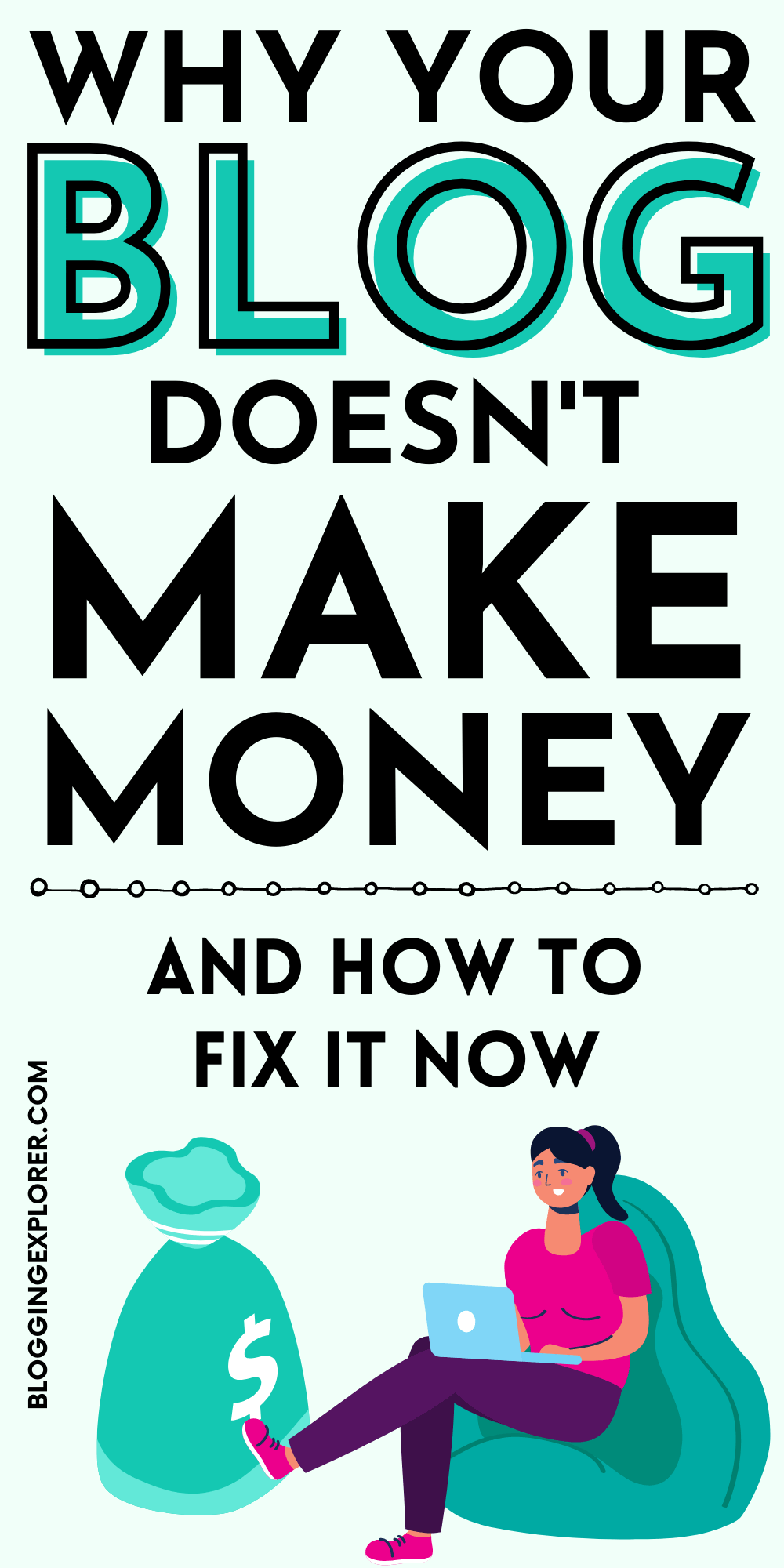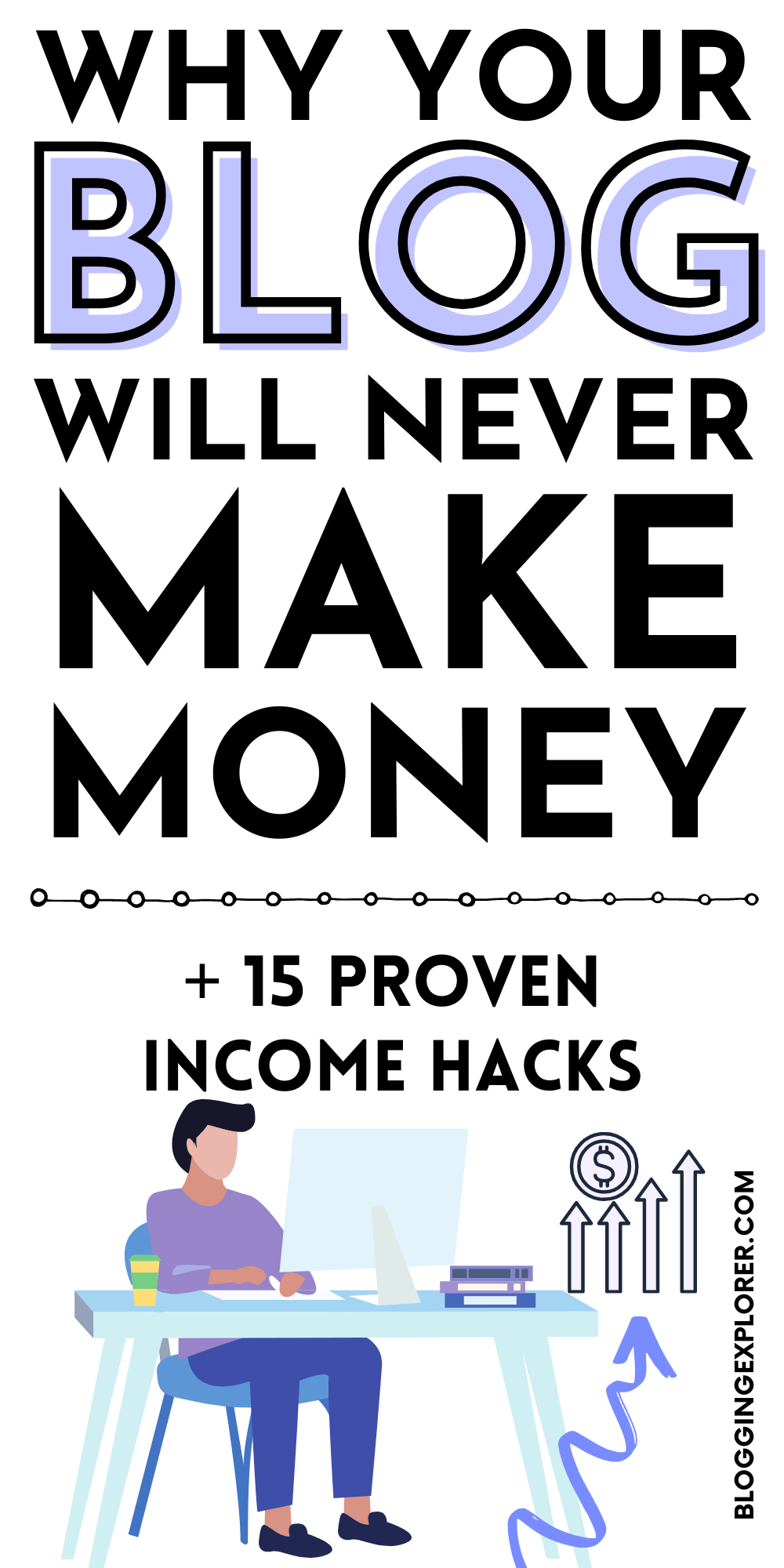Are you wondering why your blog isn’t making any money yet?
You are working hard to create content and drive traffic to your blog, but you’re just not seeing the results you expected?
If you are looking for real, actionable tips to grow your earnings, look no further.
Whether you are new to blogging or you’ve been doing it for a while, you are in the right place.
I’ve grown two of my blogs into a full-time income source since I started this journey in late 2016. It took a lot of work, and I made a ton of mistakes along the way.
Since then, I’ve helped hundreds of bloggers just like you leverage their content to earn a nice side income.
I’ve helped my readers avoid the mistakes I made so that they can see results faster than I ever did. And I love hearing how easily my techniques can make a difference.
So yes, blogging and making money from it can be learned and perfected without turning it into rocket science.
In this guide, I’ll walk you through 15 common problems most bloggers struggle with, and give you an actionable solution to all of them.
If you’re serious about starting a profitable blog this year, keep reading!
Please note: This post contains affiliate links to products I use, trust, and recommend. If you choose to purchase a helpful product using these links, I may receive a small commission for referring you – at no extra cost to you. These funds help me keep this blog up and running.
1. You don’t know who your target audience is
First things first:
Blogging is all about helping others. It’s about offering your readers what they want.
If you simply jump into writing blog posts and hope for the best, you’re doomed.
You can’t make money with your blog unless you have a clear and realistic plan.
And that plan starts by figuring out who you are blogging for.
Your blog target audience is the magic power that makes anything possible. If you want to become a successful blogger, you have to know who they are.
Once you know who your typical reader is, you can figure out what they need from you.
Your job as a blogger is to offer them targeted, helpful, and valuable content. You need to solve their problems, answer their questions, and make their lives easier.
THAT is what blogging is about. And I have the perfect solution for you…
How to fix it:
I’ve written a massive guide on how to find your blog target audience easily. Check it out now!
2. You blog about yourself
Let’s cut to the chase here:
Your readers don’t care about you.
They are looking for helpful information online. If you want your blog to make money, you need to give them what they want.
So if you’re one of those bloggers who only write about themselves, you’re screwed.
We just talked about how important it is to know who your target audience are.
If you want to monetize your blog, you need to deliver value and publish useful, meaningful content that solves their problems.
Find out what they struggle with, and offer them a solution.
If you manage to make your readers’ lives easier, your blog income will start growing before you even know it. And the more visitors you generate, the more money you can make.
How to fix it:
Not sure what you should blog about to help your readers?
No worries. Check out these smart hacks to come up with blog post ideas quickly.
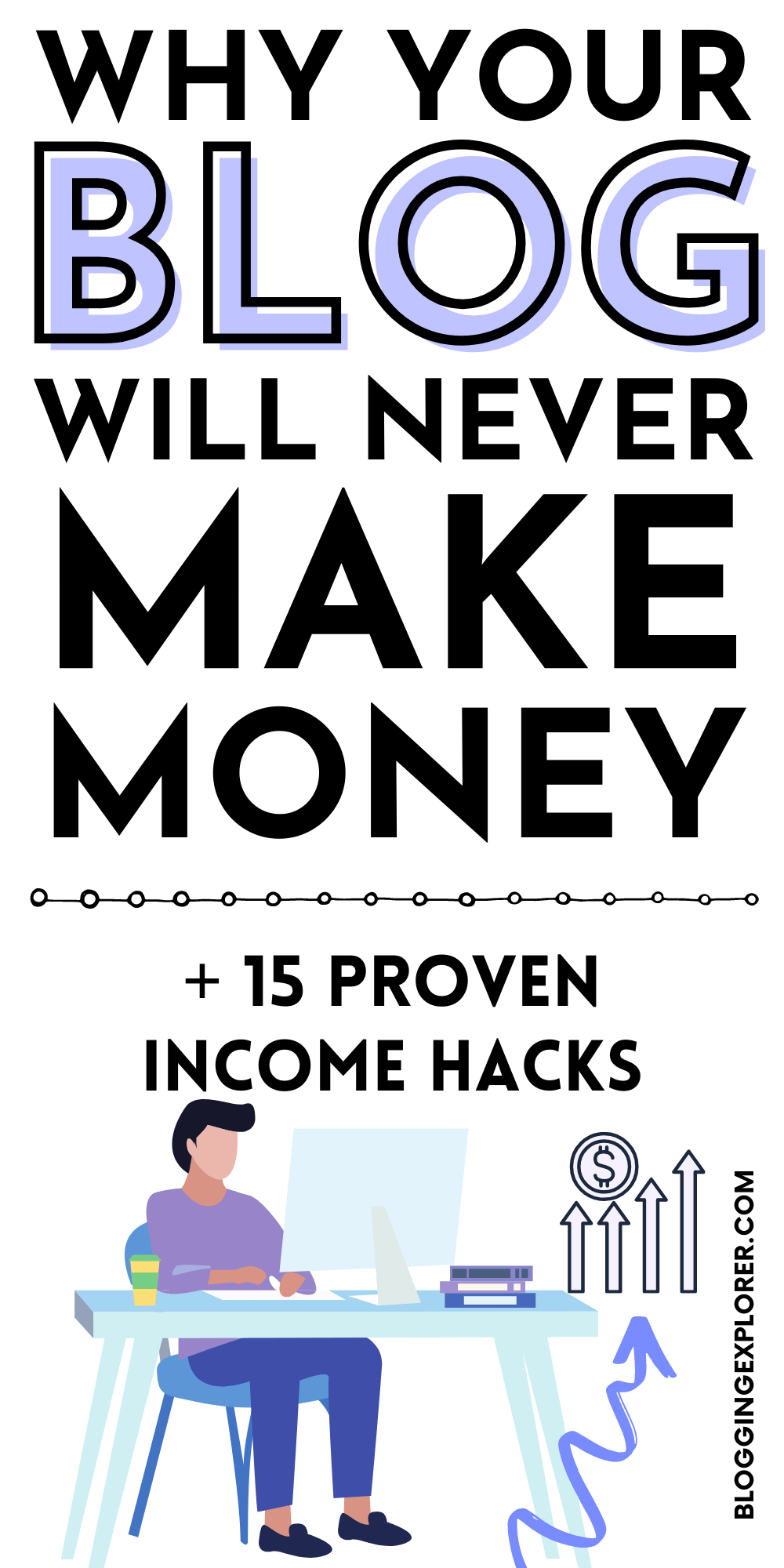
3.You aren’t blogging consistently
Now that you know what to blog about, it’s time to set up a consistent blogging strategy.
I know how easy it is to write a few blog posts when you feel like it, and then just forget about your blog for months.
That’s a massive no-no, my friend.
If you’re serious about making money with your blog, consistency is key.
When you publish new, helpful content regularly, both your readers and Google will pick up on it.
Google loves new content. As long as you know what your readers need from you, and you write relevant, targeted blog posts that solves their problems, you’re golden.
How to fix it:
Start by looking at your schedule. How much time can you dedicate to your blog?
Be realistic. If it’s only an hour every week, no problem. Block that hour in your schedule for blogging, and eliminate all distractions.
Building a blog is just like any other hobby or job. You need to take the time, and prioritize.
That time is away from other things you could be doing. And it’s up to you whether you are willing to make that sacrifice.
4. You’re guessing instead of knowing
When you publish a new blog post, are you 100% sure it’s going to take off and generate traffic?
Are you absolutely certain that it’s what your readers need?
If not, you’re wasting your time creating all that content.
You’re guessing what could work, and work your butt off to put together a detailed blog post without knowing whether your hard work will pay off.
And when your blog posts only generate a handful of clicks, your motivation goes down the drain. You give up blogging altogether, and your blog income gets stuck at $0.
Sounds familiar?
How to fix it:
If you want to make money with your blog, you need to know exactly what you’re doing.
You need to know what your readers need, and what they’re actively searching for.
Again, think about your target audience. What do they want right now?
You need to be on top of current trends and seasonalities in your blog niche.
Some niches are very seasonal, and others generate steady traffic all year round.
To find out what your audience needs from you, use Google Trends. It’s a quick tool for figuring out what’s popular right now and which topics in your niche are going up and down in search volumes.
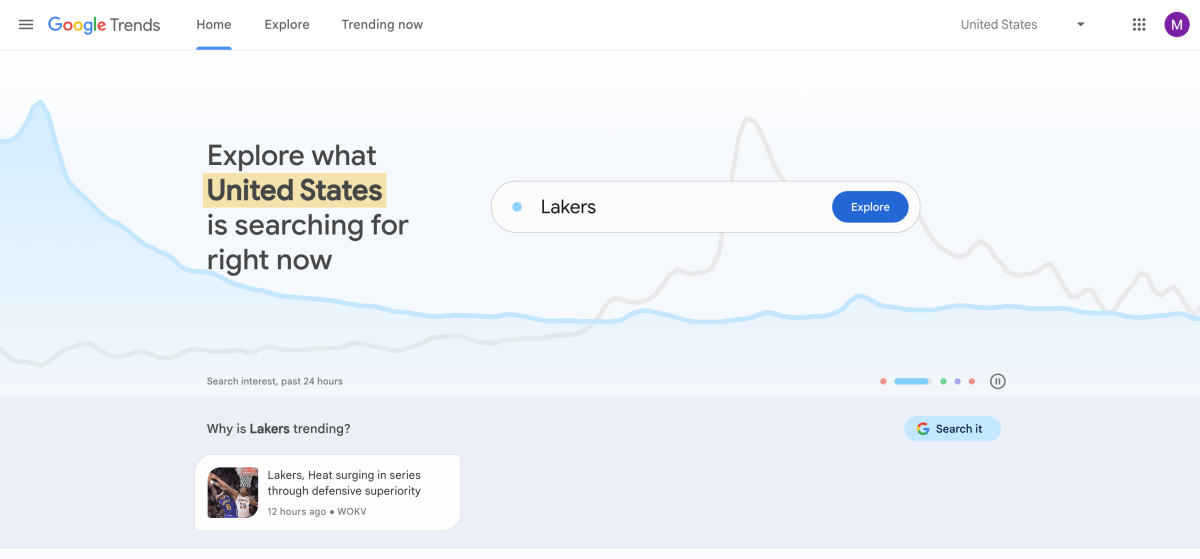
5. Your content isn’t focused enough
If you’re read my guide on how to start a successful blog, you know how important it is to be very, very focused with your content.
You want to blog about an extremely narrow, targeted topic when you’re starting out.
Why?
Because it’s the only way to:
- Appeal to your target audience
- Show Google that you’re going to become an expert
- Stay focused in your content creation workflow
If you blog about a dozen topics, you’re simply making things harder for yourself.
For example, I love Pinterest marketing. I managed to grow my blog traffic very quickly using my proven Pinterest marketing strategy back in 2018 to 2019.
I also love sharing my experiences with other Pinterest enthusiasts. That’s why I try to create as detailed and in-depth articles on that topic as I possibly can.
And my readers absolutely love my guides. (You’re the best!)
The more Pinterest articles I publish, the better I rank on Google, too.
Like my Pinterest SEO guide that ranks #1 on Google:
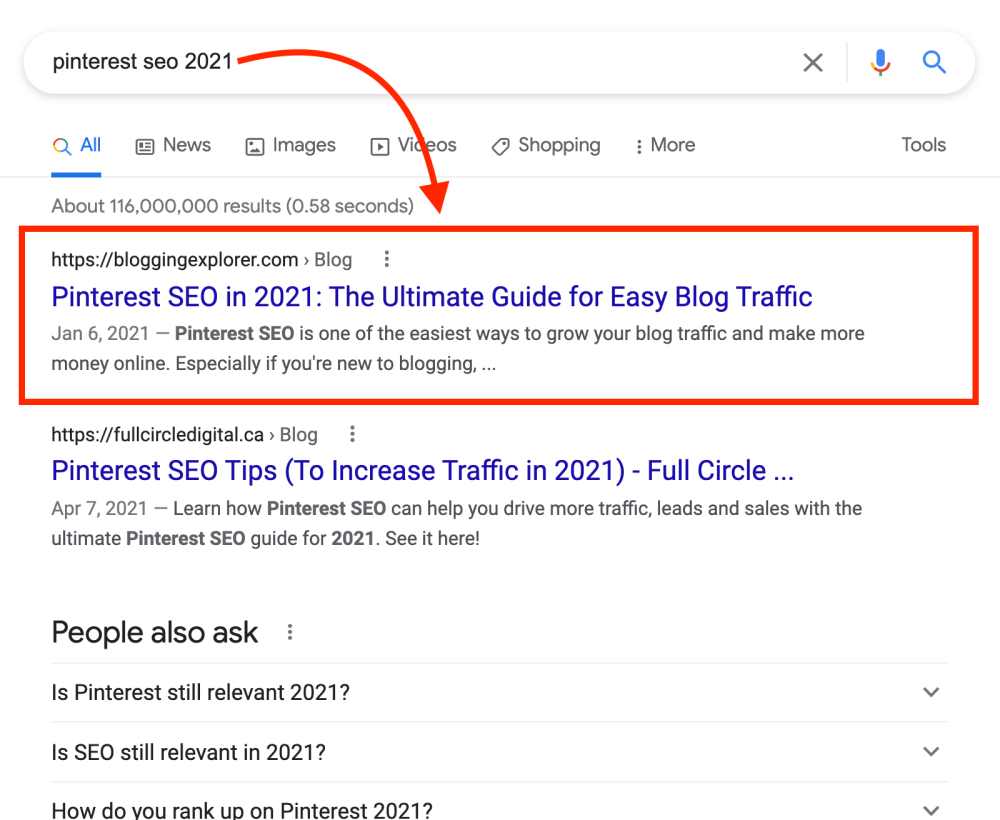
I get a ton of clicks with this single keyword because I focus on a specific topic and publish top-notch content.
My organic traffic grows for free, and even more Pinterest enthusiasts discover my blog. It’s a powerful snowball effect that ramps up if you just maintain your focus.
When you position yourself in a very specific, narrow topic and become an expert in that area, both your traffic and blog income will grow.
How to fix it:
If you are new to blogging, you may not have a clear idea of what to blog about exactly.
In that case, check out my step-by-step guide on what to blog about to find the perfect niche for your blog now.
What’s your focus topic going to be? Drop me a line in the comments below!
6. You use a free blogging platform
Let’s talk about the technical side of how to make money blogging.
Even if you are entirely new to blogging, you have probably heard of a few free blogging platforms, such as WordPress.com, Blogger, etc.
Learn more in my article about WordPress.com vs. WordPress.org.
Now, while it may feel like an easy way to get your blog up and running on a free platform, you won’t make much money with it.
Free blogging tools are easy to get started, but difficult to grow a business.
Here are a few reasons why you should NOT use a free platform to start your blog:
- Limited monetization methods:
Depending on the platform, you may not be allowed to use affiliate links, for example. Also, your blog will display ads, but you won’t get any money from them. The “free” platform receives all ad revenue your blog content generates. - You don’t own your traffic:
When you start a free WordPress blog, your blog URL will be something like myawesomeblog.wordpress.com. You don’t own the domain name, and you’re simply boosting the platform itself by producing content and driving traffic to their domain. - Limited customization options:
If you are serious about making money with your blog, you want to create a brand that people recognize easily. Thus, you need to be able to customize the look and feel of your blog, right? The customization options on free blogging platforms are slim to none. - You don’t own your content:
You will spend hours, days, and weeks creating high-quality blog posts that your audience will fall in love with. But with free blog platforms, if you read the terms and conditions carefully, you will see that you won’t own the content you produce. The moment you publish an article, you’re handing over all your rights to the platform – for free.
So while “free” blogging platforms may seem like an easy way to launch your blog, I would never recommend using them if you want to earn money with blogging.
How to fix it:
If you ask me, the only way to launch a blog that people will take seriously is to use a self-hosted blogging platform, such as WordPress.org.
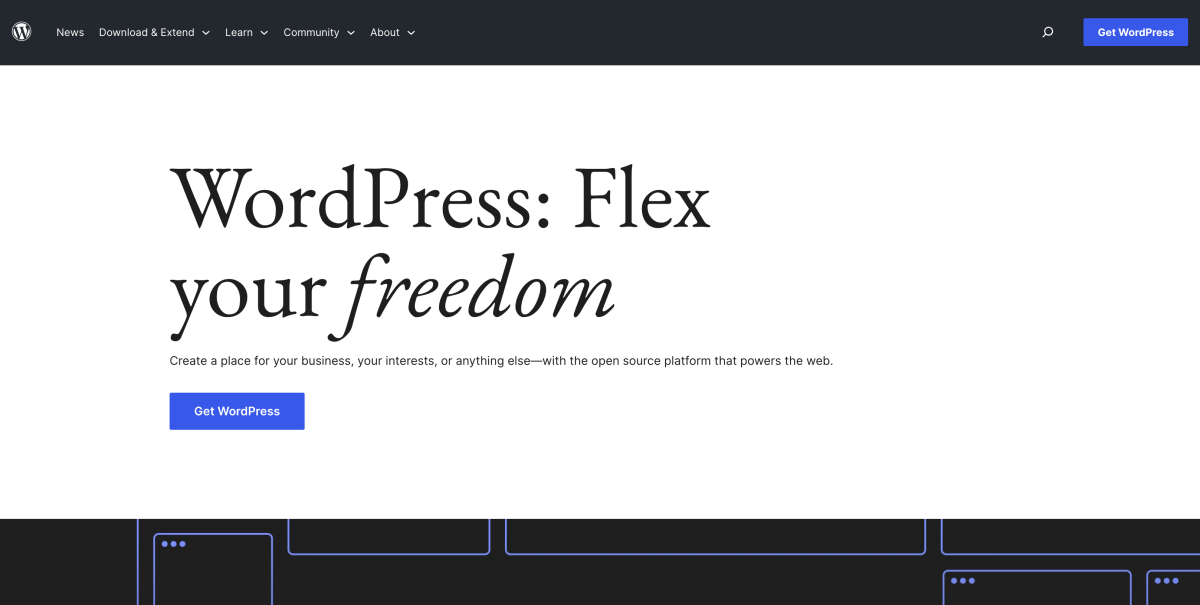
If you aren’t familiar, “self-hosting” means that you will:
- Sign up for a blog hosting plan with a reliable, legit provider
- Register your own domain name (the URL for your blog website)
- Use the WordPress blogging software to manage your blog
I know this may sound too technical and overwhelming, so don’t worry. I’m here to help you out.
You are free to use whichever provider for your blog hosting, but the most convenient way is to join me and host your blog on Bluehost.
They take care of everything for you. You simply need to sign up for a hosting plan, and they will give you a free domain name AND install WordPress for you automatically.
I’ve used a handful of hosting providers since I built my first website in 2016.
I recommend Bluehost to everyone because they’ve offered the best value for my money, and I’ve had the best overall experience with them.
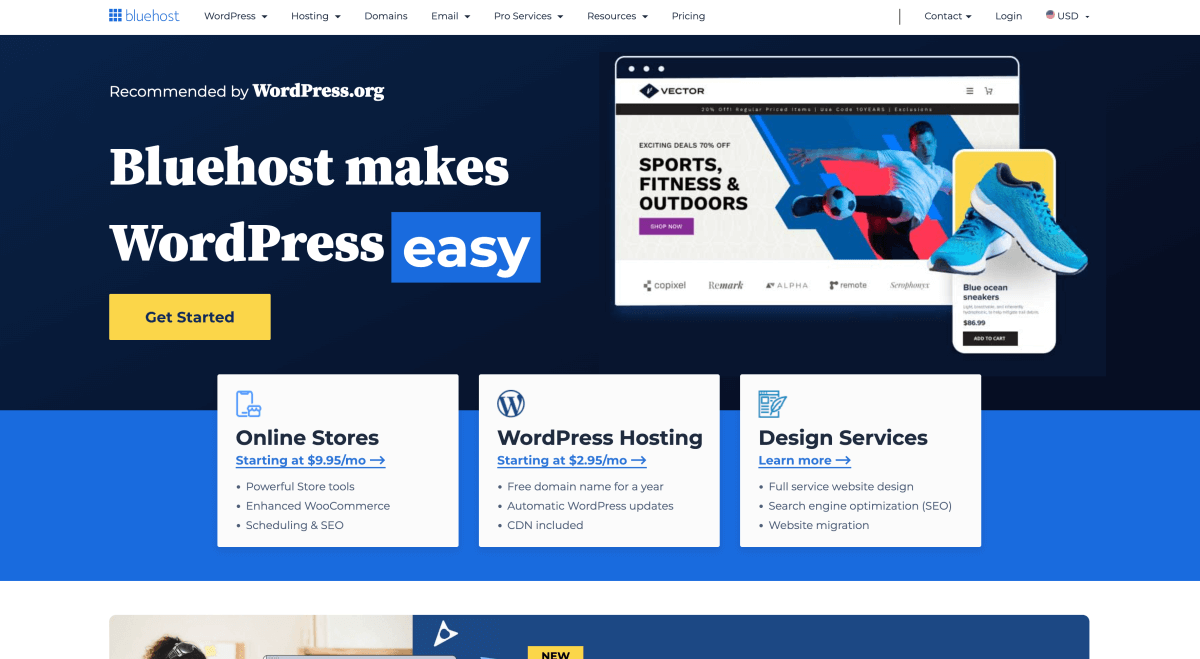
For more details, check out my guide on how to find the best blog hosting when you’re new to blogging.
Remember: if you have any questions at all about hosting, domain names, or WordPress, please drop me a line in the comments section. I’m happy to help!
Here’s how you can take care of the technical setup for your blog right now:
- Head over to Bluehost.com.
- Follow my step-by-step guide on how to start your blog with them in just 30 minutes.
I’ll see you inside the guide!
7. Your blog website isn’t loading fast enough
Did you know that 40% of your visitors will abandon your blog if i takes more than 3 seconds to load?
Or that 47% of your visitors expect your website to load in less than 2 seconds?
Page speed is one of the most important – and also easiest – things you should pay attention to.
If you don’t take care of loading speed, your blog becomes bloated, your visitors will leave your website, and your blog income takes a dive.
Because less traffic means less affiliate commissions, less ad income, and less product sales.
Especially if you use WordPress, I know how easy it is to add new features and functionalities to your blog – even when they’re not 100% necessary.
Because the ugly truth is:
If you are not an experience WordPress specialist, you can’t know which plugins and themes you should (and should not) be using.
So where should you start?
How can you make your blog website load faster, attract more visitors, and make more money with your blog?
It doesn’t have to be complex or too technical. Let me show you:
How to fix it:
To make sure your blog website loads fast, pay attention to these four essential points:
1: Use good blog hosting
If your blog is new, it’s OK to use the cheapest hosting plan with Bluehost. You don’t need more at this point.
If you already have more traffic, you may need more power and performance. In that case, you can upgrade to a higher tier plan.
I’ve hosted all my blogs on Bluehost, starting with the Basic plan and moving my way up to Pro whenever I’ve needed better technical performance.
More recently, I moved my biggest blog to a managed, high-performance hosting plan with Kinsta.
With 50,000–100,000+ monthly visitors, having a solid, blazing-fast technical setup makes a big difference to my traffic, Google rankings, and blog income.
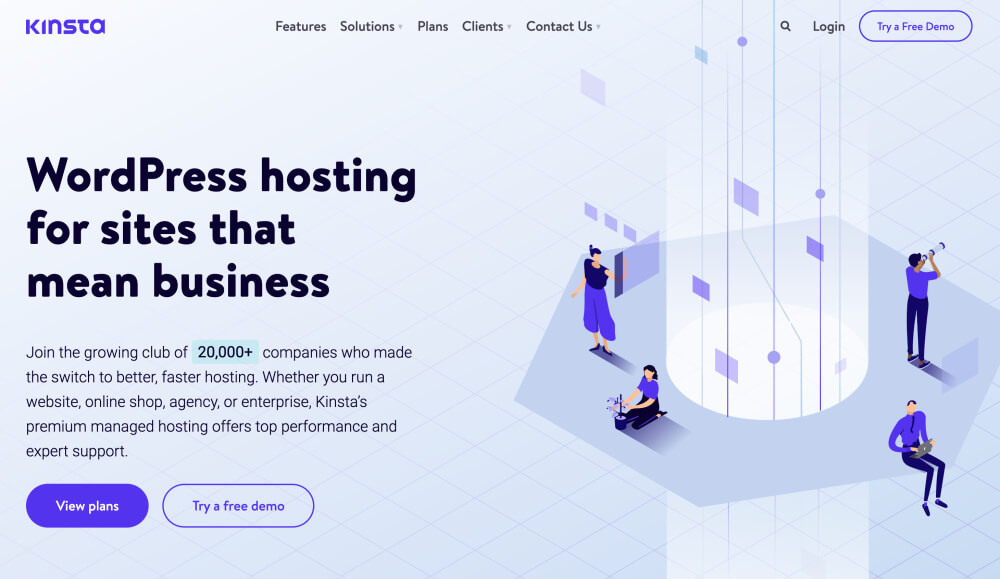
If you’re wondering what’s the right option for your blog, I’m more than happy to help you out. Just leave me a comment below and I’ll get back to you asap.
2: Clean up your WordPress plugins
Never install a WordPress plugin unless it’s 100% necessary for your blog strategy. I’m a WordPress specialist, so you can always reach out to me if you’re not sure. Again, drop me a line in the comments.
I’ve also written a guide on the best WordPress plugins for bloggers. Check it out!
3: Use a free caching plugin
Caching sounds technical, yes. It simply means that your individual blog posts and pages will be stored in a compressed format, so that they load faster.
I use the free WP Fastest Cache plugin for this website, for example. It’s easy to configure, and it can speed up your blog website within minutes.
For my bigger blog, my hosting provider Kinsta takes care of caching automatically.
4: Compress your images before uploading
Before you upload an image to WordPress, always resize it and compress the file first. You don’t want to upload anything before you’ve reduced the file size as much as you can.
With the right tools, your images will stay clear and crisp – but they will load much faster.
You can find free online tools to get the job done easily: I use Reduce Images for resizing, and tinyJPG for image compression.

8. Your content isn’t engaging enough
Now that we’ve covered the technical side of how to make more money with your blog, it’s time to discuss your content.
Here’s the deal:
The only way to make money blogging is to create content that your readers love.
You need to offer them as much value and help as you can.
If your content is meh and your readers aren’t getting what they need, you won’t earn any affiliate commissions or generate product sales.
How can you create engaging content, then?
How to fix it:
First of all, you need to know who your target audience is. This is what blog monetization boils down to – regardless of what you blog about.
Every blog has its own audience and readership. Those readers have their unique needs and wants.
They come to your blog for a reason: they need help or information about a specific topic.
Your blog content needs to solve their problems, answer their questions, and make their lives easier.
Hence, you need to figure out what your audience is searching for online.
- What type of content do they need and want?
- What type of content is already available?
- How can I create even more in-depth blog posts than what’s out there?
- How can I deliver even more value than other bloggers in my niche?
Creating engaging content isn’t difficult. The easiest way to find out what your readers want is keyword research. Which brings me to my next point…
9. You don’t know what keywords to use
If you’re simply relying on your gut when coming up with content ideas, your blog will never take off.
Blogging about random ideas and bouncing back and forth between multiple topics is a recipe for disaster.
When search engines look at your blog, all they see is a big mess. If you publish blog posts on a dozen different topics, Google can’t know what your blog is really about.
As a result, their search engine can’t be sure who’d be interested in visiting your website in the first place.
So how do you fix this?
How to fix it:
You need a content strategy.
And you need a consistent keyword strategy.
You need to know what keywords your readers use to find helpful content on Google. That’s the only way to figure out what’s missing, and how you can offer better content than your competitors.
I use KWFinder to find low-competition keywords that are relatively easy to rank with – even when I don’t have a lot of content on my blog.
I can simply type in a keyword idea, and KWFinder shows me a list of related keywords and how difficult they are to rank with.
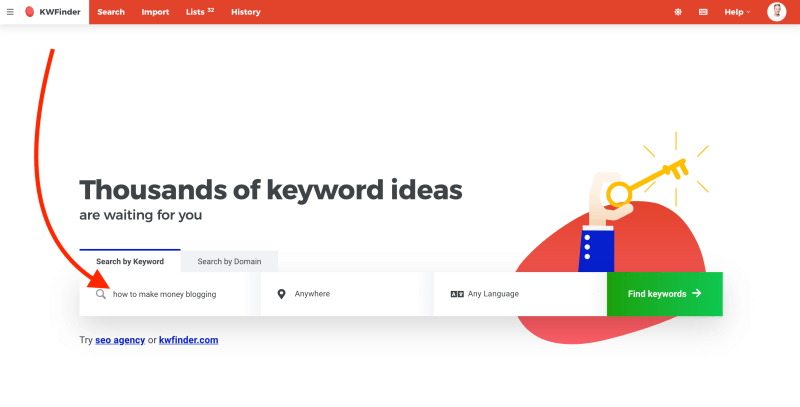
This tool is hands-down the easiest way to find an endless supply of keywords and blog post ideas that people are actually searching for and interested in reading.
For example, let’s search for “pinterest marketing strategy” and see what comes up:

On the left, we see a list of related keywords with monthly search volumes and keyword difficulty:
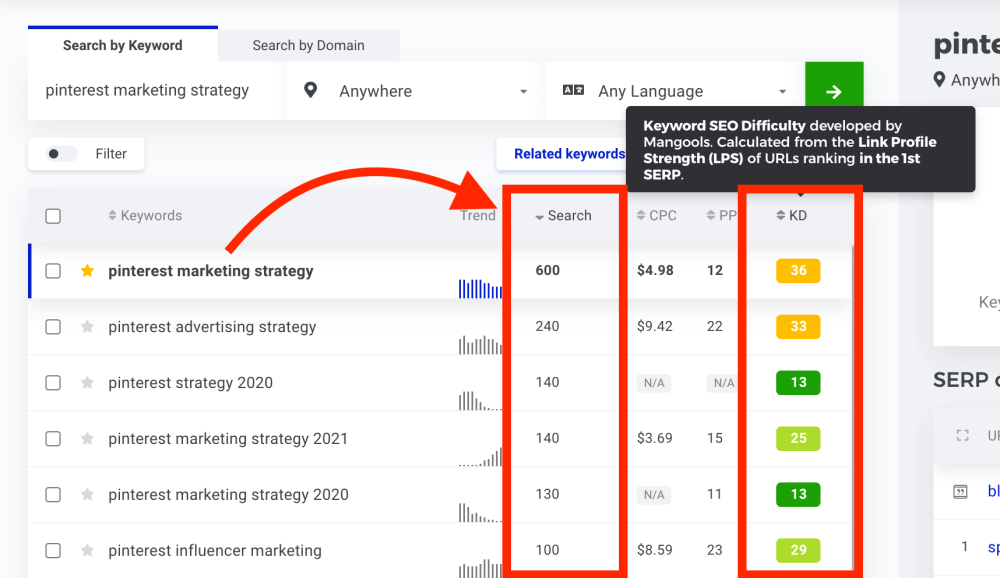
We see that the top keywords get 100–600 hits monthly – which is OK for the targeted traffic you need to make money with your blog.
The keyword difficulty “KD” indicates how easy it is to rank for a specific keyword. The lower the score, the easier it gets:

For our Pinterest marketing keywords, the top keywords are all still fairly easy to rank for. And THAT is exactly what you want!
This is how I find the keywords I write about, and KWFinder is by far one of the best investments I ever made.
But knowing your keywords is one thing. It’s a start, but you need to know how to use those keywords the right way.
Let’s talk SEO:
10. You don’t know SEO
Knowing your keywords is the starting point for making sure you are helping your target audience.
If you know what they struggle with, you can create content that solves their problems. Offering them tons of value means that you can start making money with your blog, too.
But you don’t want to stop at keywords, nope.
If you simply start writing your next blog post, include your keyword, and think you’re done, think again.
There’s a lot more to SEO than knowing your keywords, my friend.
You also need to know how to optimize your content for search engines. Let’s have a look:
How to fix it:
Even if you don’t know anything about SEO, this doesn’t have to be difficult.
Yes, you could invest hundreds of bucks in expensive SEO courses. Or you could just follow my lead and use free, beginner-friendly tools and see results faster.
Start by installing the free Yoast SEO plugin for some quick help. It’s the #1 SEO plugin worldwide – and super easy to use.
You can find and install Yoast SEO in your WordPress dashboard in Plugins > Add New:
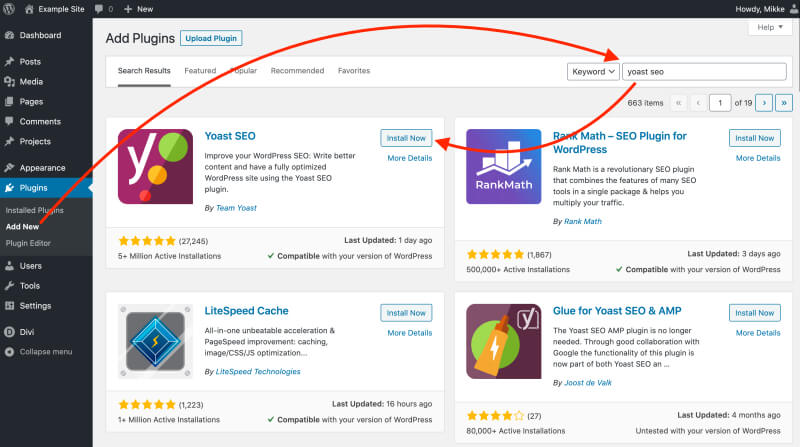
The plugin gives you valuable, actionable feedback for improving your blog posts while you are writing them.
Thus, you don’t have to remember all best practices for writing SEO-focussed content. Yoast SEO will do the heavy lifting for you and show you what to do.
In your WordPress blog post editor, you will see a dedicated section for Yoast SEO, with hands-on tips for improving your article:
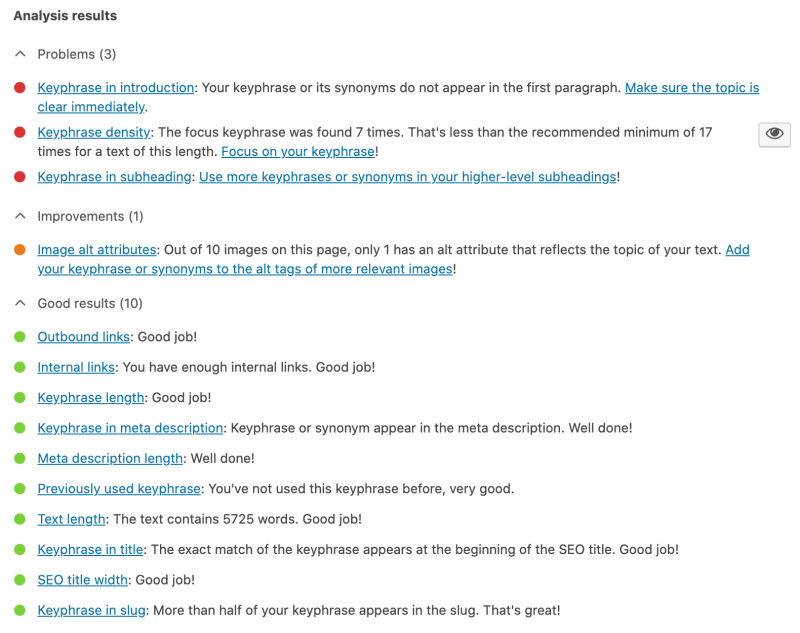
The traffic light system is intuitive and easy to follow. It doesn’t get any more straightforward than this.
This is a great starting point for nailing your SEO. Don’t overthink it.
When your blog takes off and you generate more traffic and income, you can always learn more about SEO if you wish.
But for now, this is more than enough to get started.
If you are new to SEO, you can learn more in my SEO guide for beginner bloggers.
11. Your blog isn’t getting enough traffic
SEO is one of the best ways to drive free, targeted traffic to your blog.
But there’s one big downside:
It takes time to see results from your SEO efforts.
As long as you follow the best practices I just showed you, you will see visitors. But it could take anywhere between 2–6 months to see substantial traffic from Google, depending on your blog topic and competition.
And the sad truth is:
If you blog isn’t making enough money yet, it’s most probably because you don’t have enough blog traffic.
The more visitors you get, the better opportunities you have to generate revenue.
More people means:
- More clicks on your ads
- More affiliate commissions
- More product sales
- More cooperation requests from brands
Driving more visitors to your blog is the best way to make more money. But it’s also one of the trickiest to master.
Sure, you will see some traffic once search engines see what you’re doing, and they start showing your blog posts in search results.
But that could take months – even years.
And I know you don’t want to wait. You want traffic asap.
I also know that you don’t want to spend thousands of bucks on ads.
So what’s the best way to generate free blog traffic fast?
How to fix it:
The fastest way to drive visitors to your blog is to use the right mix of traffic channels.
Again, we’re back to talking about your target audience, but here I go:
You need to be mindful of where your readers hang out online. Figure out where they spend their time and where they search for helpful content.
Depending on your blog topic, your audience may only use Facebook, for example. Or they are very active on Twitter and use Google to find information.
Obviously, you need to distribute your content to the right channels. And it’s up to you know find out what those channels are.
Here are my favorite ways to grow your traffic and your earnings:
- Pinterest:
The largest visual search engine worldwide. Very easy to get started with, but you need a clear Pinterest marketing strategy to use it the right way. Come say hi! - Google SEO:
My favorite for sustainable long-term traffic. The basics are easy to learn and apply, and your traffic ramps up quickly once you get the ball rolling. - Twitter:
Allows you to connect with your readers “face-to-face”. Use Twitter to find out what your audience needs, and share helpful content to generate clicks to your website. However, don’t over-promote yourself. Twitter users want quick, hands-on tips, not just links to your website. - Facebook:
One of the best traffic channels for most blog niches. Find groups in your niche, join them, and help others with what you know. Again, don’t just self-promote. Answer questions, offer helpful tips, and share your story. - Quora:
The best place to find out what people want to know when it comes to your blog niche. Search for a topic, find a question you can answer, and write the best, most valuable and helpful answer you can to earn upvotes and gain momentum.

What traffic channels are you using? Which ones have worked best for you so far? Please share your thoughts in the comments section!
12. You aren’t using Pinterest (yet)
Ah, my favorite topic of all times… Pinterest marketing. (This is what I do best!)
Out of all traffic channels I’ve used throughout the years, Pinterest is the best for generating traffic to brand new blogs.
So if you only have a handful of blog posts and Google isn’t sending any traffic to your blog yet, sign up for Pinterest right now.
If you’re not familiar, Pinterest is much more than a platform with pretty home decor and dinner recipe photos.
Pinterest is the biggest visual search engine worldwide with over 400 million monthly users.

You can use Pinterest to drive thousands of visitors to your blog and start making money – for free.
The best part?
Pinterest users are known for being prepared to spend money. They are searching for ideas and inspiration for their next product purchase.
So whether you want to monetize your blog by promoting affiliate products or selling your own, you don’t want to miss out on what Pinterest can offer.
How to fix it:
Here’s how you can start driving traffic to your blog with Pinterest:
First, start by creating a free Pinterest business account here.

Next, follow my detailed Pinterest marketing guides one by one:
And finally, follow these best practices to make the Pinterest algorithm happy.
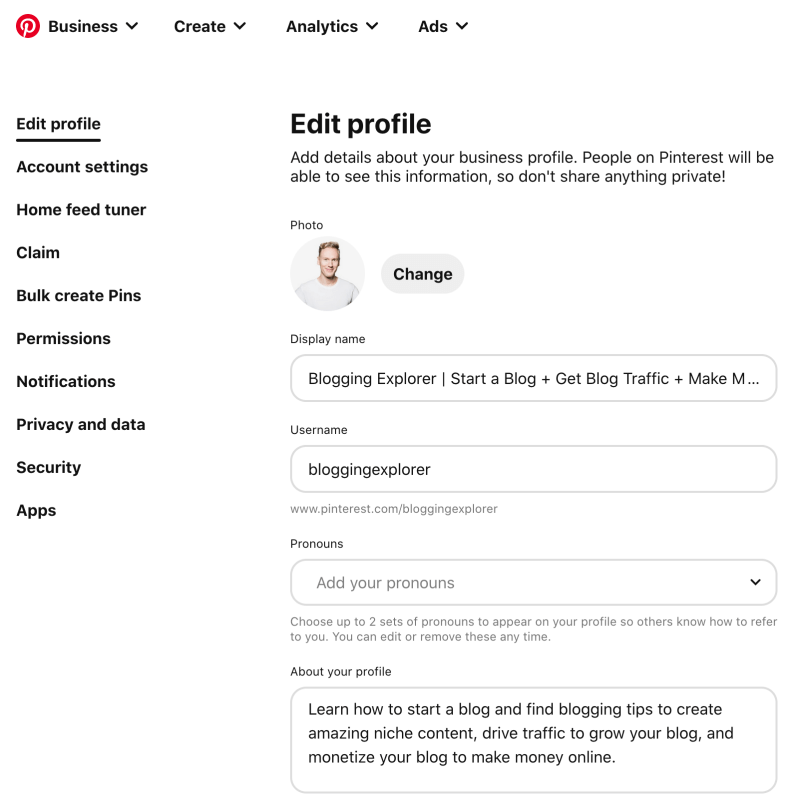
I’m a massive fan of Pinterest marketing, and I love sharing what I’ve learned throughout the years with my readers.
If you are serious about growing your blog traffic fast, I’m more than happy to guide you!
To see the best results as quickly as possible without wasting your time on strategies that don’t work, grab my Smart Pinterest SEO guide and steal my best, most exclusive strategies:
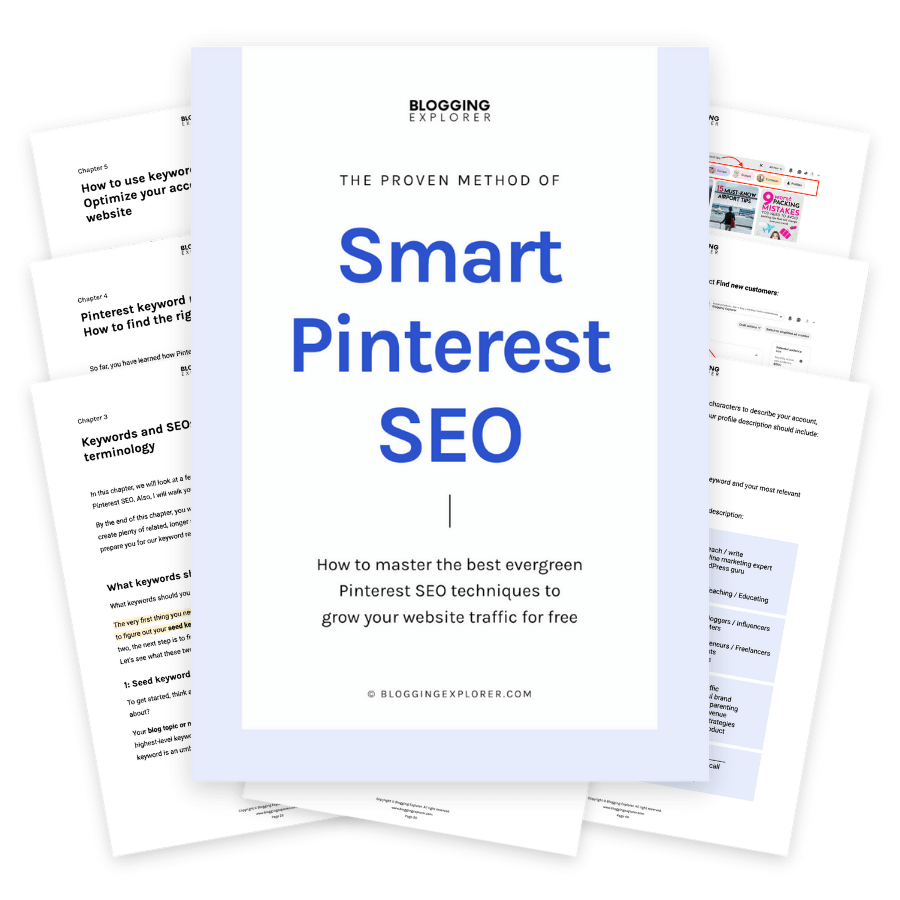
In this guide, I reveal how I leveraged Pinterest to grow my traffic by +138% in just 6 weeks back in 2019. In just 6 weeks, I more than doubled my traffic, and of course, more than doubled my blog income, too.
I used timeless, evergreen techniques that work in any niche, no matter how often the Pinterest algorithm gets updated.
And all my techniques are universal, whether you’re just getting started or have a Pinterest account that you want to boost with tactics that really work.
Check out my guide here and feel free to get in touch with me if you have any questions about it!
13. You are not selling anything
Now that we’ve talked about how to get visitors to your blog, it’s time to figure out how you’ll convert that traffic into blog income.
So let me ask you the obvious question:
Are you selling anything on your blog?
Do you have a product or a service that delivers value to your readers?
If you’ve followed the tips in this guide so far, your blog should be packed with the right type of content.
You know who your target audience are and what they struggle with. You know what keywords they use to find information, and you’ve managed to drive them to your blog.
Now is the perfect time to present them with the perfect product that can make their lives easier.
How to fix it:
Think about your readers. Why are they reading your blog posts? What value do you offer them with your content?
Next, think about your own experiences with your blog topic.
- Have you used a product, service, or tool in the past that made your life easier?
- Did something help you solve a problem you were struggling with?
Chances are that you have the perfect product in mind for your readers based on what you’ve experienced.
Here are a few examples:
- If you blog about skincare, you certainly know of a skincare product that’s a good fit for your readers.
- If you blog about gardening, you could recommend a few practical gardening tools everyone needs.
- If your blog is about dessert recipes, your readers would surely appreciate knowing what utensils and kitchenware you use, right?
Most companies have affiliate programs. You can join to become an affiliate partner, and recommend a product to your readers using a special affiliate link to the product page.
When someone clicks on your link and makes a purchase, you will earn a commission for referring them.
It’s a win-win! Your readers find products and tools they could use, and you earn money for every referral.
Affiliate marketing is a quick way to monetize your blog because you don’t have to create your own products. You can simply pick a product you use and love, and recommend it to your audience.
To get started, follow my ultimate guide to affiliate marketing for beginners.
14. You don’t have a monetization strategy
So once you’ve found your first affiliate product, you’ve taken a huge step towards making more money with your blog.
But you don’t want to stop there.
To turn your blog into a successful online business, you need to go further.
If you stick to a single affiliate product, you are putting all your eggs in one basket.
Who knows, maybe that product will be out of fashion next year. Or there’s another product that solves the same problem at a fraction of the price.
My point is:
You want to diversify.
You want to use a mix of multiple income methods for a diversified monetization strategy.
That way, you’ll see a more consistent income stream from your blog, and a decrease in one income source can be balanced out by others.
How to fix it:
Here are a few monetization methods you should consider:
- Affiliate marketing:
Start this as early as possible. Also, leverage Pinterest for your affiliate marketing strategy. - Display ads:
I’m a big fan of display ads because they bring in 100% passive income. However, you need a lot of traffic to make a lot of money. Display ads are a good complementary monetization method, so definitely try it out. - Selling your own products:
When you create your own products and sell them via SendOwl, you get to keep all the profits. I like to create small digital products that are easy to use and offer instant value, such as my Canva Pinterest templates or my crazy-popular Ultimate Pinterest Marketing Bundle. - Selling services:
Are you familiar with content creation, social media marketing, Pinterest marketing, or even SEO? Then you should offer these services to others through your blog! - Sponsored content:
Once your blog grows and generates visibility, brands may approach you for sponsored content. If you’re not sure how much to charge, use this blogger rate card to get a good overview.
Which methods are you using? Do you have plans for using new methods this year?
Drop me a line in the comments below – I’d love to hear about your plans!
15. You gave up on your blog too soon
Last but not least, let’s talk about consistency and expectations.
I know you want to make money from your blog as quickly as possible. We all do.
Chances are that you started blogging some time ago, felt excited to publish blog posts, and spent days and weeks getting everything set up.
But when you didn’t see the money rolling in right away, you gave up.
That’s why 99% of all bloggers fail at earning any income.
And I don’t want you to be one of them.
How to fix it:
You know, blogging is difficult. It takes a lot of hard work and determination to see real results.
It usually takes several months to see any substantial income from your blog. Some people start earning faster, some slower – that’s just part of the fun, and perfectly OK.
But as long as you have a clear goal and a strategy to follow, you are all set.
Most importantly, stop comparing yourself to other bloggers who are making six figures and more.
They had to work hard to achieve what they have. They didn’t become millionaires overnight.
So you have to start somewhere. You need to earn your first $5, then $10, and soon $50, and more.
We all start small.
When I started monetizing my first blog in January 2018, I made $4 in that first month.
It was the best feeling ever!
The following month: $117.
Step-by-step, those numbers kept growing. And I shared my best tips for making that happen in this article.
It’s all about thinking long-term. You won’t achieve quick wins with blogging, but your income will ramp up once you get the ball rolling.
And you know what?
I’m here to help you out! I’m a real person, and I love connecting with my readers. I really mean it.
Please feel free to share any thoughts, questions, and ideas in the comments section below. I’d love to hear more about your blogging journey and your plans!
Final thoughts: Why your blog isn’t making money
This was a massive post, but I hope you found a few helpful ideas for improving your blog and making money from it this year.
Let me sum up the whole article into one sentence:
If you want to make money blogging, you need to know what your target audience needs, and offer them the best possible content you can.
So it’s not about promoting random stuff and hoping that someone will purchase your product and click on your affiliate links. I see those blogs all the time and it just makes me sad.
If you are serious about becoming a pro blogger, you need to be a team player and show your readers that you’re there for them.
Just think about yourself: what types of blogs do you like to read? What makes you subscribe to a newsletter, purchase a product, or sign up for a quick masterclass?
Most likely, those blogs have their sh*t together, know what they talk about, and offer value and help for your problems and questions, right?
With all the lessons you learned from this guide, you can head over to my massive guide about how to make money blogging step-by-step.
Remember what you learned here, and apply your insights to your blog starting today!
